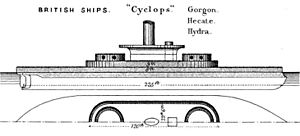HMS Hecate (1871) facts for kids

Right elevation plan from Brassey's Naval Annual 1888–1889
|
|
Quick facts for kids History |
|
|---|---|
| Name | HMS Hecate |
| Namesake | Hecate |
| Builder | J & W Dudgeon, Cubitt Town, London |
| Cost | £156,782 |
| Laid down | 5 September 1870 |
| Launched | 30 September 1871 |
| Completed | 24 May 1877 |
| Commissioned | April 1872 |
| Out of service | 1901 |
| Refit | 1885–86 |
| Fate | Sold for scrap 12 May 1903 |
| General characteristics | |
| Class and type | Cyclops-class breastwork monitor |
| Displacement | 3,480 long tons (3,540 t) |
| Length | 225 ft (68.6 m) (p/p) |
| Beam | 45 ft (13.7 m) |
| Draught | 16 ft 3 in (5.0 m) (deep load) |
| Installed power | 1,579 ihp (1,177 kW) |
| Propulsion | 2 shafts, 2 inverted compound steam engines |
| Speed | 10.5 knots (19.4 km/h; 12.1 mph) |
| Range | 3,000 nmi (5,600 km; 3,500 mi) at 10 kn (19 km/h; 12 mph) |
| Complement | 156 |
| Armament | 2 × twin 10-inch rifled muzzle loaders |
| Armour |
|
HMS Hecate was a special kind of warship called a breastwork monitor. She was one of four ships in the Cyclops class built for the Royal Navy in the 1870s. Hecate was the last ship of her class to be finished.
Contents
What was HMS Hecate?
HMS Hecate was a powerful warship designed to protect coasts and harbors. She was part of a group of ships known as the Cyclops-class monitors. These ships were built with very strong armor and large guns, making them tough opponents.
Ship Design and Features
The Cyclops-class ships were an improved version of an earlier design called the Cerberus class. They were built to be sturdy and well-protected.
Size and Speed
Hecate was 225 feet (68.6 m) long, which is about the length of seven school buses. She was also 45 feet (13.7 m) wide. When fully loaded, she sat 16 feet 3 inches (4.95 m) deep in the water. The ship weighed about 3,480 long tons (3,540 t), which is like the weight of over 3,000 cars!
Her crew included 156 officers and sailors. Hecate had two powerful steam engines that turned two propellers. These engines could produce 1,472 indicated horsepower (1,098 kW) of power. This allowed her to reach a top speed of 11.2 knots (20.7 km/h; 12.9 mph) (about 13 miles per hour). She could travel 3,000 nautical miles (5,600 km; 3,500 mi) (about 3,450 miles) at a speed of 10 knots (19 km/h; 12 mph) before needing to refuel.
Powerful Guns
The ship was armed with four large 10-inch guns. These were rifled muzzle-loading guns, meaning they were loaded from the front and had special grooves inside the barrel to make the shells spin. This spinning made the shells fly straighter and hit their targets more accurately.
The guns were placed in two gun turrets, one at the front and one at the back of the ship's main structure. Each turret held two guns. These guns could fire both solid cannonballs and explosive shells. They used hydraulic jacks to help raise and lower them for aiming.
Strong Armor
The Cyclops class ships were very well protected. They had a thick belt of wrought iron armor around their waterline, which is the part of the ship that sits in the water. This armor was 8 inches (203 mm) thick in the middle and 6 inches (152 mm) thick at the ends.
The main structure of the ship, called the superstructure, and the conning tower (where the ship was steered) were also heavily armored. They had 8–9 inches (203–229 mm) of wrought iron. This heavy armor around the guns is why these ships were called "breastwork monitors." The gun turrets themselves had 10 inches (254 mm) of armor on their front and 9 inches (229 mm) on their sides and back. All this metal armor was backed by 9–11 inches (229–279 mm) of strong teak wood, which added extra protection. Even the decks were armored with 1.5 inches (38.1 mm) of thick iron.
Her Story and End
HMS Hecate was officially launched on September 30, 1871, but she wasn't fully completed until May 24, 1877. She was put into service in April 1872.
Along with her sister ships, Cyclops and Gorgon, Hecate was taken out of active service in January 1902. This meant she was no longer used for fighting. The following year, on May 12, 1903, she was sold for scrap. This means she was broken down, and her materials were reused.

